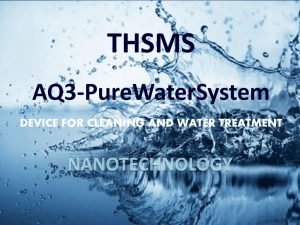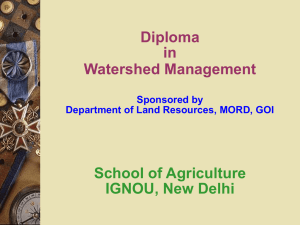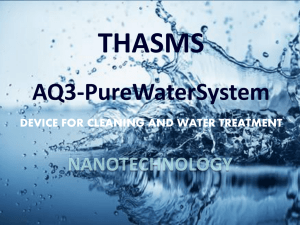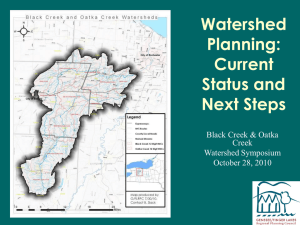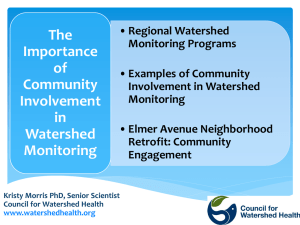Chapter 11
advertisement
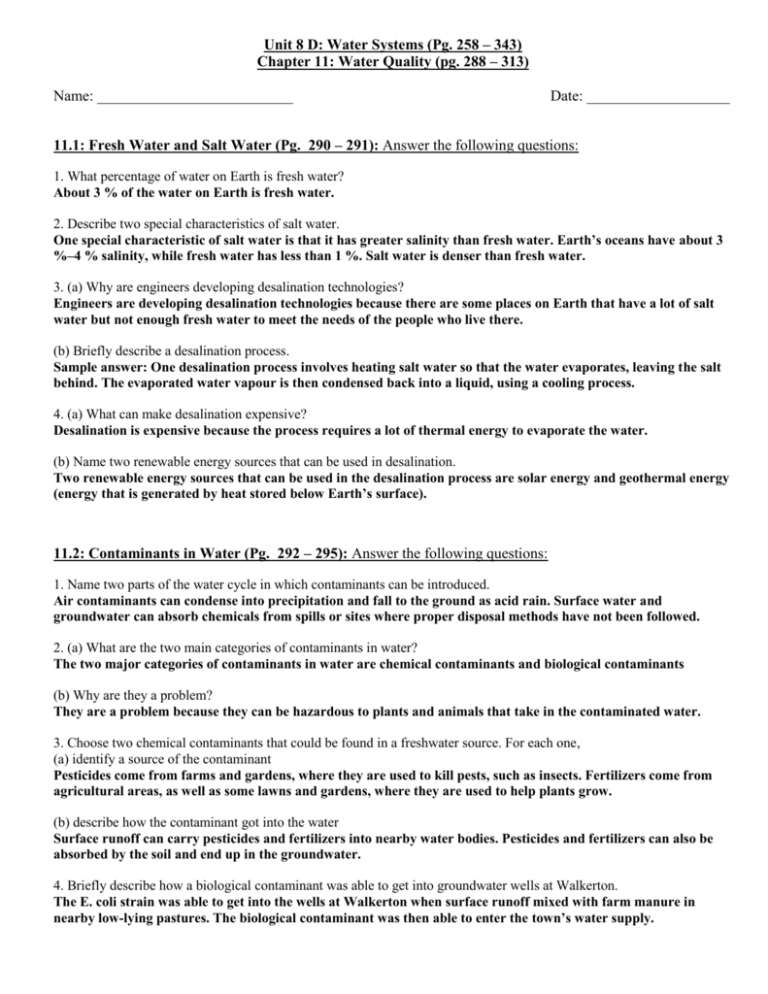
Unit 8 D: Water Systems (Pg. 258 – 343) Chapter 11: Water Quality (pg. 288 – 313) Name: __________________________ Date: ___________________ 11.1: Fresh Water and Salt Water (Pg. 290 – 291): Answer the following questions: 1. What percentage of water on Earth is fresh water? About 3 % of the water on Earth is fresh water. 2. Describe two special characteristics of salt water. One special characteristic of salt water is that it has greater salinity than fresh water. Earth’s oceans have about 3 %–4 % salinity, while fresh water has less than 1 %. Salt water is denser than fresh water. 3. (a) Why are engineers developing desalination technologies? Engineers are developing desalination technologies because there are some places on Earth that have a lot of salt water but not enough fresh water to meet the needs of the people who live there. (b) Briefly describe a desalination process. Sample answer: One desalination process involves heating salt water so that the water evaporates, leaving the salt behind. The evaporated water vapour is then condensed back into a liquid, using a cooling process. 4. (a) What can make desalination expensive? Desalination is expensive because the process requires a lot of thermal energy to evaporate the water. (b) Name two renewable energy sources that can be used in desalination. Two renewable energy sources that can be used in the desalination process are solar energy and geothermal energy (energy that is generated by heat stored below Earth’s surface). 11.2: Contaminants in Water (Pg. 292 – 295): Answer the following questions: 1. Name two parts of the water cycle in which contaminants can be introduced. Air contaminants can condense into precipitation and fall to the ground as acid rain. Surface water and groundwater can absorb chemicals from spills or sites where proper disposal methods have not been followed. 2. (a) What are the two main categories of contaminants in water? The two major categories of contaminants in water are chemical contaminants and biological contaminants (b) Why are they a problem? They are a problem because they can be hazardous to plants and animals that take in the contaminated water. 3. Choose two chemical contaminants that could be found in a freshwater source. For each one, (a) identify a source of the contaminant Pesticides come from farms and gardens, where they are used to kill pests, such as insects. Fertilizers come from agricultural areas, as well as some lawns and gardens, where they are used to help plants grow. (b) describe how the contaminant got into the water Surface runoff can carry pesticides and fertilizers into nearby water bodies. Pesticides and fertilizers can also be absorbed by the soil and end up in the groundwater. 4. Briefly describe how a biological contaminant was able to get into groundwater wells at Walkerton. The E. coli strain was able to get into the wells at Walkerton when surface runoff mixed with farm manure in nearby low-lying pastures. The biological contaminant was then able to enter the town’s water supply. 11.3: Testing Water Quality (Pg. 296 – 297): Answer the following questions: 1. List at least three factors mentioned in this section that decrease water quality. Three factors that can decrease water quality are high turbidity, high temperature, and high acidity (low pH). 2. How can you test a water source to see whether it is acidic or not? To determine if water is acidic, you can test the water using indicator strips that turn different colours in acidic or basic water. 3. What is thermal pollution? How do nuclear power plants contribute to thermal pollution? Thermal pollution is the artificial increasing of the temperature of water. Nuclear power plants contribute to thermal pollution because they use water to cool their machinery then return the warmed water to rivers and lakes. 4. How could each of the following substances enter a freshwater source? (a) chlorine: It could enter a freshwater source through its role in the water treatment process. Chlorine is deliberately added to water to kill unwanted organisms. (b) nitrates: It could enter a freshwater source through fertilizer runoff from fields, lawns, gardens, or golf courses. (c) calcium: It could enter a freshwater source when groundwater dissolves minerals in rocks. (d) acid: It could enter a freshwater source through acid rain, which occurs when air pollutants are absorbed by the water vapour in the air and then condense into precipitation. 11.4: Watersheds (Pg. 298 – 300): Answer the following questions: 1. (a) Describe how a continental divide affects the direction of water flow over land. A continental divide affects the water flow over land by separating the water and ice on each side of the divide so that they flow downhill in different directions. (b) Name a continental divide, and describe where it is. One continental divide is the Great Divide, which runs from northern Alaska all the way down to South America. 2. Explain the meaning of the term “watershed.” A watershed is an area of land that drains into a single water body. 3. Briefly describe the role of a Conservation Authority. A Conservation Authority acts as caretaker for a particular watershed. It must balance human needs with the needs of the environment, and its members are responsible for designing, promoting, and implementing plans that protect the water systems within that particular watershed. 4. What is the process called in which organisms are used to remove contaminants from the environment? Bioremediation is the process that uses organisms to remove contaminants from the environment. 5. Describe, with an example, how each of the following organisms removes contaminants from water: (a) micro-organism: Micro-organisms, such as bacteria, remove contaminants from the water by breaking down certain pollutants and removing them from the environment. (b) plants: Plants remove contaminants from the water by absorbing certain toxic metals found in the water (much like a sponge). When the plants are removed, the metals are removed as well. 11.7: Wastewater Treatment (Pg. 306 – 307): Answer the following questions: 1. Explain in your own words how greywater is different from blackwater. Blackwater contains feces and urine. Greywater does not contain those contaminants; it contains other household contaminants, such as soaps and bleach. 2. List two sources of wastewater. Toilets and sinks are two sources of wastewater. 3. What is the purpose of the primary stage of sewage treatment? The primary stage of sewage treatment removes any solids from the water. 4. Explain the difference between a septic system and a sewage system. Unlike a sewer system, a septic system treats wastewater on a small scale, using a single tank and few steps. In addition, the treated water from a septic system is released into the ground, instead of being released into surface water. Chapter 11 - Review (pages 312 - 313) Name: __________________________ Date: ___________________ What Do You Remember? 1. In your own words, define “salinity” and “concentration.” Salinity is a measure of how much salt is dissolved in water. Concentration is a numerical description of the amount of a substance dissolved in a solution. 2. How does a continental divide affect the flow of water? A continental divide affects the flow of water by separating the water and ice on each side of the divide so that they flow downhill in different directions. 3. (a) What is a watershed? A watershed is an area surrounded by high land that is drained by a single river and its tributaries. It catches all of the runoff water and diverts it toward a common destination. (b) Explain how a stream can be part of more than one watershed. A stream can be part of more than one watershed because smaller watersheds are nested inside larger ones. For example, a watershed could contain several streams that feed into a single river. That river in turn feeds into a large bay (which is another watershed), and, from there, water flows out to the ocean. 4. Write a sentence that includes the term “bioremediation.” After the factory was shut down, the town brought in scientists who used bioremediation to help clean up the polluted lake. What Do You Understand? 5. Describe the difference between a water table and a watershed. A water table is the “surface” of a body of groundwater that is found beneath the ground. A watershed is an area of land that is drained by a single water body. 6. Why might a farmer apply the following to a field of tomato plants? (a) fertilizer: A farmer might apply fertilizer to a field of tomato plants to help give the plants extra nutrients that will help them grow. (b) herbicide: A farmer might use herbicide on tomato plants to kill weeds that are competing with the tomato plants for space and nutrients. (c) pesticide: A farmer might use pesticide on tomato plants to kill insects that are feeding on the leaves of the plants. 7. Describe the possible effect of each of the following activities on a freshwater source: (a) the application of road salt to melt snow and ice on winter roads Applying road salt to melt snow and ice on winter roads could contaminate nearby freshwater sources because the salt is carried away by runoff water that flows into those water sources. (b) transportation by ships Transportation by ships could contaminate the water in lakes and oceans if there is a shipping accident or leak that causes the spill of chemicals into the water. 9. (a) Explain the term “wastewater.” Wastewater is any water that is discharged from homes or businesses because it has been used or otherwise contaminated by human activity. (b) Identify three sources of wastewater in your community. Three sources of wastewater in my community are parking lots, the local pool, and the office where my mother works. 10. Many parts of the Great Lakes watershed are polluted. Pollution “hot spots” have been identified, along with remedial action plans to fix each one. (a) What is a remedial action plan? A remedial action plan is a specific plan of action to clean up certain “hot spots” that are major areas of concern because they are polluted. (b) How do you know when a remedial action plan is complete and the identified hot spot cleaned? You know that a remedial action plan is complete when the specific goals for the polluted hot spot that were outlined in the original plan have been met. Solve a Problem! 13. a) Describe turbid water. Turbid water has many small particles of sediments or other solid matter, so it looks very murky and opaque. b) Describe two methods you could use to remove the turbidity from water. Two methods of removing the turbidity from water are filtration and sedimentation. B - Chapter 11:


